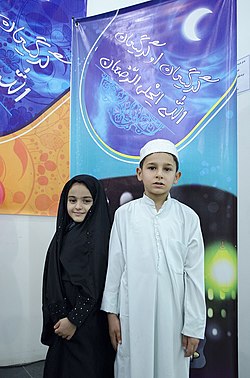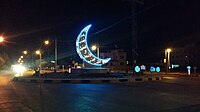Gargee'an (Arabic: قرقيعان), sometimes spelled as Gerga'oon (Arabic: قرقاعون), is a semiannual[1] celebration, observed primarily in Eastern Arabia. It takes place on the 15th night of the Islamic month of Sha'ban for Shia Muslims and on the 15th night of Ramadan for all sects. It is celebrated by children and adults alike dressing in traditional attire and going door-to-door to receive sweets and nuts from neighbours, as they sing traditional songs. It’s more of a tradition than a religious affiliation so both Sunni and Shia celebrate it. The tradition has existed for hundreds of years, and is deeply rooted in some parts of the Gulf culture,[2] especially in Iraq, Kuwait, Bahrain and Saudi Arabia.[3]
Although the celebration of Gargee'an shares superficial similarities with the Western Halloween custom of trick-or-treating, Gargee'an has no connection with horror and developed independently.
Etymology and alternative names[edit]
The exact origin of the word Qarqī'ān is unknown though several theories exist. One states that it is derived from Qarqa'ah (Arabic: قرقعة “click”, “snick”), referring to the sound of iron pots carrying the sweets hitting each other while serving the sweets.[2] Another theory says that children in Medina sang "Qarrat Al-'Ain, Qarrat Al-'Ain" (Arabic: قرة العين, literally "eye water-parsnip" or wideleaf waterparsnip, but figuratively "darling" and also a title of poet Táhirih).
The holiday is known by other names in the wider Arab world: Majeena or Garangao in Iraq,[4][5] Garangao or Garangaou in Qatar, Gargaaown in Bahrain, Al-Nasifa in Qatif, Karkee'aan or Qariqaan in Saudi Arabia, Gargee'aan or Girgian in Kuwait, Ahwaz, Qaranqashoh, At-Tablah or Qarnakosh in Oman, and Hag Al-Leylah in the UAE. Kurds also celebrate this holiday, and call it Barrat.
Religious significance[edit]

Both Gerga'oon nights are significant to Shia Muslims. Shia believe that Gerga'oon on the 15th of Sha'ban marks the birthday of Muhammad al-Mahdi, the 12th Imam.[6] Gerga'oon on the 15th of Ramadan meanwhile coincides with the birth of Imam Hasan ibn Ali, the second Imam in Shia Islam. As a result, the occasion is seen as a time of happiness and festivities by Shia Muslims, particularly in Bahrain.[7] Events at night include the preaching of sermons in mosques, and carnival-like attractions in capital cities of Eastern Arabia such as Manama.[7]
Tradition[edit]
Children gather in small choir groups in front of a home and sing. The song is intended to ask God to bless the youngest child of the family with health, and that the mother will remain happy. The more they sing, the more nuts and sweets they receive. The Garqee'an tradition is intended to spread love, happiness and affection among adults and children.
In modern times, supermarkets, corporations, and malls compete to attract children during this time via advertisements, and by offering special promotions and arranging exclusive Qarqee'an events to market themselves.[8]
See also[edit]
References[edit]
- ^ Sometimes the holiday is only celebrated annually, during the month of Ramadan.
- ^ a b "القرقاعون من أهم الاحتفالات الرمضانية الشعبية في مملكة البحرين". Bahrain News Agency. 2 August 2012. Retrieved 3 February 2013.
- ^ "بوليفارد رياض سيتي تستضيف فعالية القرقيعان الرمضانية | مجلة سيدتي". www.sayidaty.net (in Arabic). Retrieved 2022-09-10.
- ^ "Coronavirus forces Basra children to celebrate Garangao festival indoors". Reuters. 10 May 2020.
- ^ ""قرقيعان" عيد الأطفال في منتصف رمضان... واحتفالات الأهواز". Raseef22. 20 May 2019.
- ^ ""نسائية سار الرياضي" تقيم مهرجان القرقاعون الأول". Al Wasat. 15 August 2008. Retrieved 4 February 2013.
- ^ a b "القرقاعون: البحرين تحيي ليلة النصف من رمضان". Al Wasat. 20 November 2002. Retrieved 3 February 2013.
- ^ ""البحرين سيتي سنتر" يحتفل بليلة القرقاعون مساء اليوم". Al Ayam. 31 July 2012. Retrieved 3 February 2013.

Well, that’s interesting to know that Psilotum nudum are known as whisk ferns. Psilotum nudum is the commoner species of the two. While the P. flaccidum is a rare species and is found in the tropical islands. Both the species are usually epiphytic in habit and grow upon tree ferns. These species may also be terrestrial and grow in humus or in the crevices of the rocks.
View the detailed Guide of Psilotum nudum: Detailed Study Of Psilotum Nudum (Whisk Fern), Classification, Anatomy, Reproduction